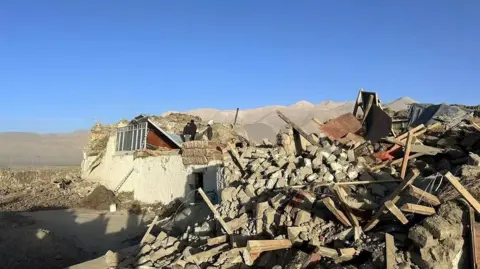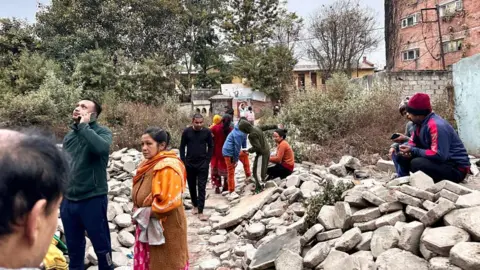 Reuters
ReutersMore than 14,000 rescue workers have arrived in Tibet to continue the search for survivors after a powerful earthquake killed at least 126 people in a remote region of western China.
Chinese state media said more than 400 people had been rescued after an earthquake struck about 50 miles from the base of Mount Everest on Tuesday, destroying thousands of homes.
Deputy Prime Minister Jiang Guoqing arrived on Wednesday to oversee the operation, which has been hampered by winter temperatures that dropped to minus 16 degrees Celsius overnight.
Earthquakes occur frequently in the region, which lies on major geological fault lines, but Tuesday’s quake was one of the deadliest in China in recent years.
According to data from the US Geological Survey, the magnitude 7.1 earthquake, which occurred at a depth of 10 km, was also felt in parts of India near Nepal and Tibet.
Internet access is restricted in Tibet, which is tightly controlled by the Chinese government, and reporters cannot travel there without government permission. Most of what we know about the earthquake and its aftermath comes from Chinese state media.
The air force was deployed and drones were dispatched to assist rescue teams as President Xi Jinping called for all efforts to minimize casualties and resettle affected residents.
The state-run People’s Daily said more than 30,000 people had moved to the area. Electricity and cell phone service in Tingri county near the epicenter were restored by Wednesday morning, according to state media.
Officials estimate that more than 3,600 buildings could collapse, potentially turning thousands into shelters.
Footage released by China’s state-run CCTV shows houses being destroyed and buildings collapsing in the Tibetan holy city of Shigatse, and rescue workers are seen wading through the rubble and distributing thick blankets to local residents.
Sangji Dangzhi, whose supermarket was damaged in the quake, told news agency AFP by phone that his home had been extensively destroyed.
“Houses here are made of dirt, so when the earthquake hit, many of them collapsed,” the 34-year-old said, adding that ambulances were transporting people to hospitals throughout the day.
A hotel resident in Shigatse told Chinese media outlet Fengmian News that he was startled awake by waves of shaking. He said he grabbed his socks and ran out into the street, where he saw a helicopter circling above.
“It felt like even my bed was being lifted,” he said, adding, “I immediately knew it was an earthquake because several small earthquakes have occurred in Tibet recently.”
More than 40 aftershocks occurred in the first hours after the quake.
Jiang Haikun, a researcher at the China Earthquake Networks Center, told CCTV that another earthquake of around magnitude 5 was possible, but “the likelihood of a bigger one occurring is low.”
Tingri County, located at the foot of Mount Everest, which separates Nepal from China, is a popular base for climbers preparing to scale the world’s highest peak.
A tourism worker told local media that Everest sightseeing tours in the area had been cancelled, adding that the area was closed. It is reported that all three visitors moved to an outdoor space for safety.
Shigatse region, with a population of 800,000, is the traditional center of the Panchen Lama, a key figure in Tibetan Buddhism with spiritual authority second only to the Dalai Lama.
Tibetan Gedhun Choekyi Niyima identified as reincarnated Panchen Lama He disappeared by China in 1995 at the age of six.. China then chose the Panchen Lama.
The current Dalai Lama said in a statement, “I pray for those who lost their lives and hope for a speedy recovery for all who were injured.”
He fled Tibet for India in 1959 after China annexed the region, and has since been seen as an alternative source of power for Tibetans angry at Chinese control.
 getty images
getty imagesStrong tremors were felt in Nepal, but no major damage or casualties were reported, but an official from the National Emergency Operations Center told BBC Newsday that “there was only minor damage and cracks in houses.”
Tuesday morning’s earthquake, which sent many Kathmandu residents rushing out of their homes, brought back memories of the deadly quake in 2015. A magnitude 7.8 earthquake occurred near Nepal’s capital Kathmandu, killing more than 9,000 people and injuring more than 20,000.
“When the earthquake happened in 2015, I couldn’t even move,” Manju Neupane, a shopkeeper in Kathmandu, told BBC Nepali. “It wasn’t that scary today, but I’m afraid that another big earthquake will hit us and we’ll be trapped between tall buildings.”







